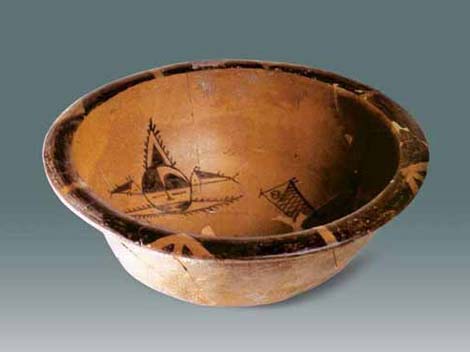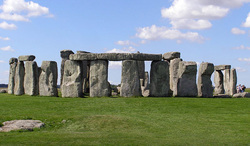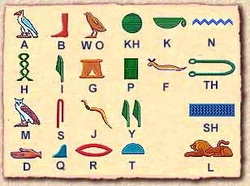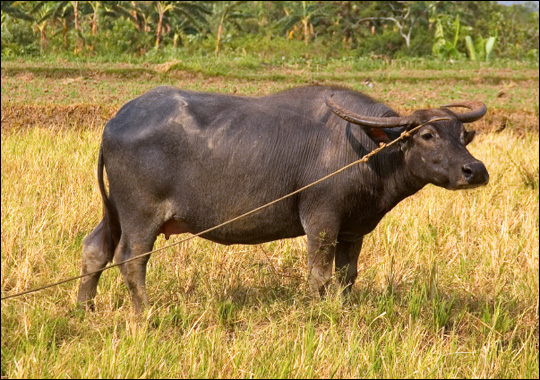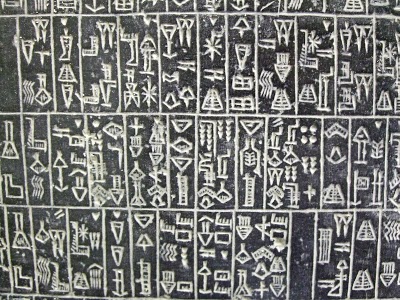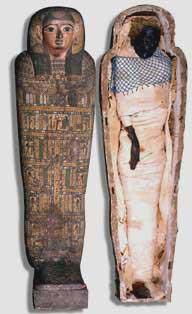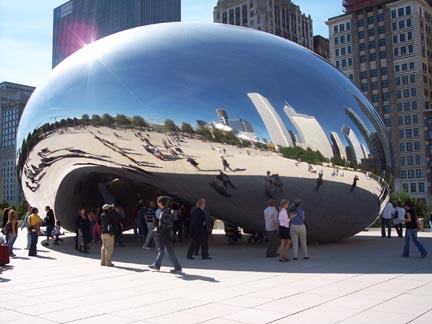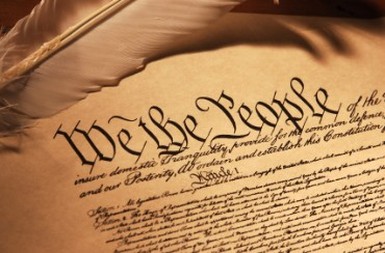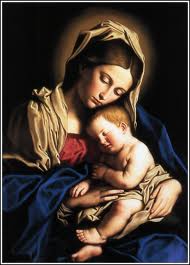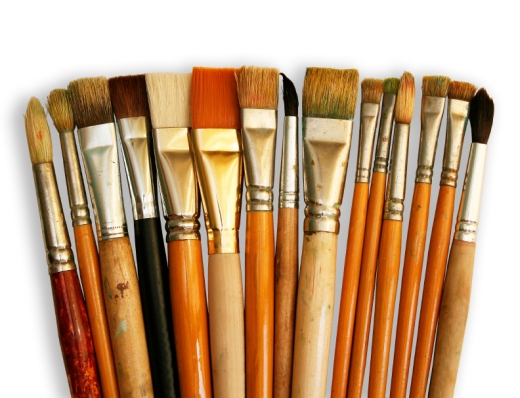AGMSPRITE
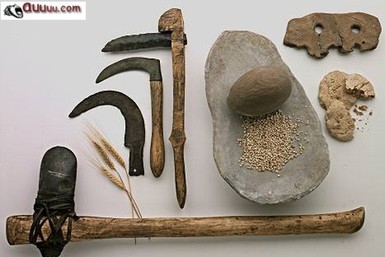
Agricultural tools from early civilizations
ART
The ever-changing art forms of ancient civilizations in the Paleolithic Era, the Neolithic Era, and society today shows the constant human innovation. People are always trying new ways to express themselves and incorporate art into their everyday lives, such as painting as a profession or the making of pottery as a cooking tool.
GEOGRAPHY
The geography of these civilizations is reflected in the use of pottery. It was used to collect food from farms, which suggests that these civilizations lived near a river with fertile soil, and other benefits of flowing water. This is different from the Paleolithic Era because it was never required to live near a river in order to ensure survival. Any water would have sufficed because they only needed a body of water to drink from; that was the only purpose. This is a continuity to modern-day society because many populous cities are near rivers or flowing water because of the requirement of resources.
MILITARY
The Stonehenge shows that a large workforce or form of military must have been assembled in order to create the massive structure. This is a change from the Paleolithic era because in the Neolithic Era, people lived in large groups for extensive periods of time allowing them to giant structures, unlike before when the nomads were constantly migrating. However, this is a continuity to now because people continue to live in large groups for extensive periods of time and produce large scale art, such as the Chicago Bean or the Joe Louis “Fist” monument in downtown Detroit.
SOCIETY
From seeing the hieroglyphics as not only a means of record keeping but also a means of decorating art, it is clear that the Egyptian society and other civilizations were extremely resourceful by ensuring everything had multiple purposes. Resourcefulness was a major change from the Paleolithic Era in that everything no longer only did one thing. For example, animals were not only a source of food but also for labor and clothing. This has been a continuity to today’s society because of the huge “Reduce, Reuse, Recycle” campaign, promoting various uses for one object.
POLITICAL
The innovation of the arts during the Neolithic and Paleolithic eras proves that humans in societies are always striving for new ways to express themselves. From a political point of view, the first written laws and orders such as Hammurabi’s code proved that those of higher classes had the privilege to maintain this art. Those who were in power would be the ones writing and setting the rules for the society to follow. Looking at today’s society, the Constitution of the United States sets the norms for the people to follow.
RELIGION
People in early societies carved sculptures and symbols on the tombs of dead, generally gods and pharaohs in Egypt. This shows that humans at that time period did have some religious beliefs. Today many religions express themselves through art such as the paintings of the Virgin Mary found in many Catholic churches.
INTELLECT
Since civilizations did not have to strive to survive after the domestication, they had time to experience art in many ways. Such things include architecture, paintings and pottery. This shows how humans today do not have to look for nutrition and a way to survive but instead go to school and get an education.
TECHNOLOGY
Tools were not used for farming anymore but were re-established for art usage. Rocks were used to carve symbols instead of hunting usage. Evolution through time shows how today’s artists us brushed to facilitate the spread of paint on a board. As Marcus Garvey once said, “A people without the knowledge of their past history, origin and culture is like a tree without roots."
The ever-changing art forms of ancient civilizations in the Paleolithic Era, the Neolithic Era, and society today shows the constant human innovation. People are always trying new ways to express themselves and incorporate art into their everyday lives, such as painting as a profession or the making of pottery as a cooking tool.
GEOGRAPHY
The geography of these civilizations is reflected in the use of pottery. It was used to collect food from farms, which suggests that these civilizations lived near a river with fertile soil, and other benefits of flowing water. This is different from the Paleolithic Era because it was never required to live near a river in order to ensure survival. Any water would have sufficed because they only needed a body of water to drink from; that was the only purpose. This is a continuity to modern-day society because many populous cities are near rivers or flowing water because of the requirement of resources.
MILITARY
The Stonehenge shows that a large workforce or form of military must have been assembled in order to create the massive structure. This is a change from the Paleolithic era because in the Neolithic Era, people lived in large groups for extensive periods of time allowing them to giant structures, unlike before when the nomads were constantly migrating. However, this is a continuity to now because people continue to live in large groups for extensive periods of time and produce large scale art, such as the Chicago Bean or the Joe Louis “Fist” monument in downtown Detroit.
SOCIETY
From seeing the hieroglyphics as not only a means of record keeping but also a means of decorating art, it is clear that the Egyptian society and other civilizations were extremely resourceful by ensuring everything had multiple purposes. Resourcefulness was a major change from the Paleolithic Era in that everything no longer only did one thing. For example, animals were not only a source of food but also for labor and clothing. This has been a continuity to today’s society because of the huge “Reduce, Reuse, Recycle” campaign, promoting various uses for one object.
POLITICAL
The innovation of the arts during the Neolithic and Paleolithic eras proves that humans in societies are always striving for new ways to express themselves. From a political point of view, the first written laws and orders such as Hammurabi’s code proved that those of higher classes had the privilege to maintain this art. Those who were in power would be the ones writing and setting the rules for the society to follow. Looking at today’s society, the Constitution of the United States sets the norms for the people to follow.
RELIGION
People in early societies carved sculptures and symbols on the tombs of dead, generally gods and pharaohs in Egypt. This shows that humans at that time period did have some religious beliefs. Today many religions express themselves through art such as the paintings of the Virgin Mary found in many Catholic churches.
INTELLECT
Since civilizations did not have to strive to survive after the domestication, they had time to experience art in many ways. Such things include architecture, paintings and pottery. This shows how humans today do not have to look for nutrition and a way to survive but instead go to school and get an education.
TECHNOLOGY
Tools were not used for farming anymore but were re-established for art usage. Rocks were used to carve symbols instead of hunting usage. Evolution through time shows how today’s artists us brushed to facilitate the spread of paint on a board. As Marcus Garvey once said, “A people without the knowledge of their past history, origin and culture is like a tree without roots."
THEN |
NOW |
Works Cited:
Brown, Robert W. "Lecture Notes: Ancient Civilizations." Lecture Notes: Ancient Civilizations. The University of North Carolina at Pembroke, 23 Jan. 2006.
Web. 04 Oct. 2012. <http://www.uncp.edu/home/rwb/lecture_ancient_civ.htm>.
"Egypt Ancient, Hieroglyphics." Egypt Ancient, Hieroglyphics. International World History Project, Jan. 2007. Web. 04 Oct. 2012.
<http://history-world.org/hieroglyphics.htm>.
German, Dr. Senta. "The Neolithic Revolution." - Smarthistory. Khan Academy, n.d. Web. 04 Oct. 2012.
<http://smarthistory.khanacademy.org/the-neolithic-revolution.html>.
"Palaeolithic Period (400,000-8000 BCE)." Lecture 1, History 101: From Prehistory to the Sumerians. Loyola University Chicago, n.d. Web. 02 Oct. 2012.
<http://www.luc.edu/faculty/ldossey/sumerians.htm>."Google Images." Google Images. N.p., n.d. Web. 04 Oct. 2012. <http://www.google.com/imgres?um=1>.
"The Neolithic Revolution." - Smarthistory. N.p., n.d. Web. 04 Oct. 2012. <http://smarthistory.khanacademy.org/the-neolithic-revolution.html>.
"Ancient Egyptian Symbolism, an Introduction." The Symbolism of Ancient Egypt, an Introduction. N.p., n.d. Web. 05 Oct. 2012. <http://www.touregypt.net/featurestories/symbolism1.htm>.Mezensky, Catherine. "The Differences in Paleolithic & Neolithic Art." EHow. Demand Media, 25 May 2011. Web. 05 Oct. 2012. http://www.ehow.com/info_8484435_differences-paleolithic-neolithic-art.html.
Web. 04 Oct. 2012. <http://www.uncp.edu/home/rwb/lecture_ancient_civ.htm>.
"Egypt Ancient, Hieroglyphics." Egypt Ancient, Hieroglyphics. International World History Project, Jan. 2007. Web. 04 Oct. 2012.
<http://history-world.org/hieroglyphics.htm>.
German, Dr. Senta. "The Neolithic Revolution." - Smarthistory. Khan Academy, n.d. Web. 04 Oct. 2012.
<http://smarthistory.khanacademy.org/the-neolithic-revolution.html>.
"Palaeolithic Period (400,000-8000 BCE)." Lecture 1, History 101: From Prehistory to the Sumerians. Loyola University Chicago, n.d. Web. 02 Oct. 2012.
<http://www.luc.edu/faculty/ldossey/sumerians.htm>."Google Images." Google Images. N.p., n.d. Web. 04 Oct. 2012. <http://www.google.com/imgres?um=1>.
"The Neolithic Revolution." - Smarthistory. N.p., n.d. Web. 04 Oct. 2012. <http://smarthistory.khanacademy.org/the-neolithic-revolution.html>.
"Ancient Egyptian Symbolism, an Introduction." The Symbolism of Ancient Egypt, an Introduction. N.p., n.d. Web. 05 Oct. 2012. <http://www.touregypt.net/featurestories/symbolism1.htm>.Mezensky, Catherine. "The Differences in Paleolithic & Neolithic Art." EHow. Demand Media, 25 May 2011. Web. 05 Oct. 2012. http://www.ehow.com/info_8484435_differences-paleolithic-neolithic-art.html.
